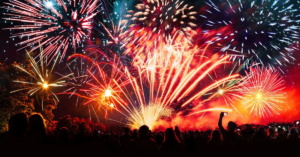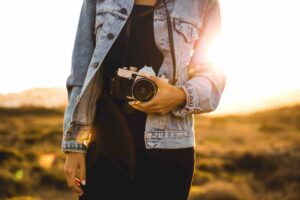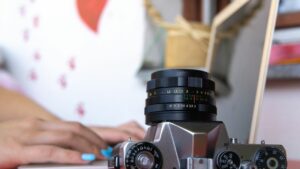Recently, I was requested to photograph a neighbourhood fireworks show. No problem, I reasoned. I adore fireworks and have photographed enough of them to be confident in my ability to supply the client with some fantastic images. However, there was one catch: the customer requested that I utilize a digital camera due to a speedy turnaround on a holiday weekend.
A feeling of unease swiftly replaced my excitement. For years, I’ve had wonderful success shooting fireworks using film. My self-assurance stems from that previous experience. Why meddle with a good thing? The client insisted on a tight deadline, and the printer required a digital file, even though there was no budget for expedited film processing and scanning. It had to be digital.
Please make no mistake: I am a huge fan of digital photography. I didn’t believe it was the best instrument for the job. So, as my left brain dealt with a slew of technical questions, my right brain appeared to win. “No problem,” I said, “I’d be delighted to shoot the assignment for you.”
Making beautiful shots of fireworks, regardless of the camera equipment you use, may be difficult. However, when shooting a pyrotechnics display, there are a few things to keep in mind.
Arrive early
Take some time before the concert to scout the venue. If feasible, strike up a conversation with the pyrotechnics team. Determine where the fireworks will be fired, and then use the topography, the height at which the fireworks will explode, and your lens selections to get a clear, unobstructed view that fulfils your compositional requirements.
Position yourself wisely
You don’t want to be in the centre of a crowd with people walking in front of your camera or, worse, kicking your tripod in the middle of an exposure. To prevent the risk of light flare, stay away from artificial light sources like streetlights. Keep an eye out for tree branches that may find their way into your composition.
Always use a tripod
Long exposure periods are required to capture the light trails of an airborne spectacle. To ensure clear exposures, long exposure times necessitate camera assistance. Bring a solid tripod, whether you’re shooting on film or with a digital camera.
Don’t forget the cable release.
Using a cable release is another approach to improve camera stability. A cable release eliminates the need to physically contact the shutter release, eliminating the risk of camera wobble. Unfortunately, a normal cable release isn’t compatible with many digital cameras. Some tasks necessitate the use of an electronic remote triggering device. Consult the camera’s manufacturer for more information.
Bring a small flashlight.
Because you’ll be shooting in the dark, bring a small light with you, so you don’t have to fiddle with your camera’s buttons and settings, let alone changing memory cards. I carry a little Maglight® flashlight with me. It’s small but durable, switches on and off with a fast twist of the wrist, and runs on two AA batteries indefinitely.
Bring extra batteries
Batteries in digital cameras deplete quickly. So if your primary batteries fail during the show, you should have backup batteries on hand.
Bring plenty of memory cards.
It’s true. I’ve been known to run out of film during a fireworks display. Don’t be so thrilled at the start that you fill up your card before the big show. That’s when the pyrotechnic experts get to perform their most spectacular aerial displays. The light, colour, and excitement in a good finale will be at their best. As a result, make sure you have enough storage space when the “big guns” go off. Also, make sure your batteries are capable of photographing the climax. When the final explosions are heading aloft, you won’t have time to adjust them.
Landscape mode
Make sure your camera is in Landscape mode, usually denoted by a small mountain range icon. It’s the same as setting the lens on a film camera to Infinity. When you use the camera in Landscape mode, you won’t have to worry about focusing issues.
Use the highest Quality-setting
You can limit the amount of compression performed on your photographs by selecting a high-Quality level. Image quality is degraded by JPEG compression, which might potentially inject artefacts into your image. Because compression artefacts are frequently observed in areas of great tonal and colour contrast, such as the dazzling coloured light of fireworks bursting against an inky black sky, this is a particular difficulty for this subject matter. Image artefacts are reduced as compression is reduced, resulting in greater image quality.
Exposure
Photographing with a digital camera is similar to photographing with slide film. You can overexpose and lose information in the highlights if you’re not careful. Because fireworks are highlights by definition, photographing them with a digital camera can be difficult.
You’ll need to be able to regulate the length of time the shutter is open. For pyrotechnics, I use a shutter speed of 1 to 4 seconds. Longer exposures tend to yield washed-out pictures, while shorter exposures don’t always capture the complete burst. Because the shutter speed must be long enough to capture the shell’s explosion, I regulate the exposure by selecting the appropriate aperture size.
You can utilize the B (Bulb) shutter speed option to alter the length of time your shutter is open. This has always been my preference. The key is to open the shutter at the start of the burst and close it when it reaches its height. It’s difficult, but not impossible, to predict the explosion. You can choose a fixed value, such as 1 second if you don’t have a B setting.
The ISO speed of most digital cameras is 100. I don’t think you should change it. That means your correct aperture will fall somewhere between /8 and/16. Watch the first few explosions of the fireworks show on the camera’s preview, as I said earlier. The hues of the red, blue, and green bursts should not be washed away by the exposure. They should appear clearly, but rather than washing out to a yellow/clear tone. They should show their true colour.
Weather can affect exposure.
Weather conditions that change frequently can add still another variable to an already challenging task. For example, even a light mist or fog can significantly impair visibility and hence affect exposure. Make the necessary adjustments.
Reduce the noise
Long exposures, high ISO settings, and even higher temperatures can cause noise in digital photos. Noise is usually seen as colourful pixel artefacts in very dark or black areas. When shooting fireworks, you can’t avoid long exposures, but you can use a lower ISO level. Increasing the ISO on your camera is similar to turning up the radio’s volume. Every pop and crackle can be heard when the signal is suddenly amplified. That is why I do not advise utilizing a higher ISO.
Noise Reduction Techniques Using Adobe Photoshop.
Making a black frame during the shoot and sandwiching it with the noisy shot is one approach to minimize the noise in a digital image. Next, place the lens cap on the lens and make an exposure with the same settings you used during the shoot to create a black frame. I normally aim to make one of these exposures before I begin shooting and another after the shoot. That way, I won’t forget about it.
In Photoshop:
- Open the black frame file alongside an image that has noise.
- Hold down Shift + drag the black frame Background layer over the noisy picture workspace to make a new layer.
- Change the black frame layer’s Layer Mode to Difference. There should be a significant noise reduction.
Other noise reduction techniques.
Are you easily irritated by loud noises? You might want to invest in some disposable earplugs to protect your sensitive eardrums. They’re available at most good pharmacies. Fireworks displays may be quite noisy! However, there should be a significant noise reduction.
It’s always more pleasant to walk along paths we’re familiar with. But, now and again, it’s a good idea to wander off the beaten path. Of course, you are not permitted to go anywhere. You might, on the other hand, come across something new and surprising. You’ll come upon something exceptional now and again. That’s when the real fun begins.













